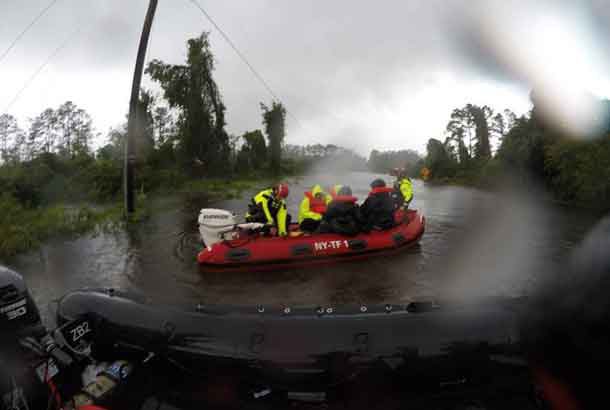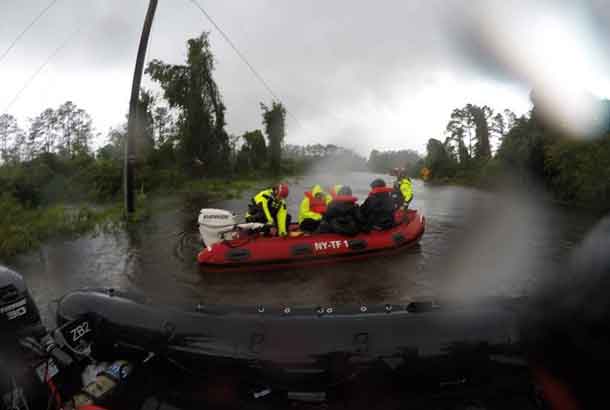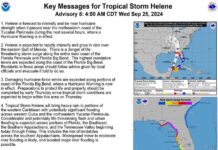
“This storm is relentless and excruciating”
* More catastrophic flooding forecast from the slow-moving storm
* Florence could drop up to 40 inches (102 cm) of rain (Updates figures for power outages, storm location, and intensity)
By Ernest Scheyder
WILMINGTON, N.C., Sept 15 (Reuters) – Tropical Storm Florence trudged inland on Saturday, flooding rivers and towns, toppling trees and cutting power to nearly a million homes and businesses as it dumped huge amounts of rain on North and South Carolina, where five people have died.
Florence diminished from hurricane strength as it came ashore on Friday, but forecasters said the 350-mile-wide storm’s (560 km) slow progress across the two states could leave much of the region under water in the coming days.
The National Hurricane Center said the storm would dump as much as 30 to 40 inches (76-102 cm) of rain on the southeastern coast of North Carolina and part of northeastern South Carolina, as well as up to 10 inches (25 cm) in southwestern Virginia.
“This storm is relentless and excruciating,” North Carolina Governor Roy Cooper told CNN late on Friday. “There is probably not a county or a person that will not be affected in some way by this very massive and violent storm.”
At 8 a.m. EDT (1200 GMT), the hurricane center said Florence had maximum sustained winds near 50 miles per hour (80 km per hour) and continued to produce catastrophic flooding in the Carolinas. It said it was located about 35 miles (55 km) west of Myrtle Beach, South Carolina, and forecasters predicted a slow westward march.
“Gradual weakening is forecast while Florence moves farther inland during the next couple of days, and it is expected to weaken to a tropical depression” by Saturday night, the center said in a bulletin. On Thursday, Florence was a Category 3 hurricane on the five-step Saffir-Simpson scale with 120-mph winds (193 km). It was downgraded to Category 1 before coming ashore on Friday near Wrightsville Beach close to Wilmington, North Carolina. The hurricane center downgraded Florence to a tropical storm later in the day.
About 10 million people could be affected by the storm.
A mother and baby were killed when a tree fell on their home in Wilmington. The child’s injured father was hospitalized. In Pender County, a woman died of a heart attack. Paramedics trying to reach her were blocked by debris.
Two people died in Lenoir County. A 78-year-old man was electrocuted attempting to connect extension cords while another man died when he was blown down by high winds while checking on his hunting dogs, a county spokesman said.
In New Bern, at the confluence of the Neuse and Trent rivers in North Carolina, the storm surge overwhelmed the town of 30,000.
Officials in New Bern, which dates to the early 18th century, said more than 100 people were rescued from floods and the downtown are was under water by Friday afternoon. A spokesman for the town said between 60 and 75 people were awaiting rescue on Saturday morning.
New Bern’s mayor told CNN that 4,200 homes were damaged in the city.
Resident Jay Manning said he and his wife watched with alarm as water filled the street.
“We moved all the furniture up in case the water comes in but the water seems to be staying at the edge of the driveway,” he said, adding that if the wind picks up and the rain keeps coming, that could change. “My wife’s in a panic right now.”
Dan Eudy said he and his brother were awakened on Thursday night by the sound of a boat ramming against his front porch.
Eudy said his family stayed in their home partly to protect their house. “And we had no belief it would be as significant an event as it was,” he said. “This is a 500- or 1,000-year event.”
Authorities in North Carolina said nearly 814,000 customers were without power. The figure for South Carolina was 170,000 customers.
More than 22,600 people in North Carolina were housed in 150 shelters statewide, including schools, churches and Wake Forest University’s basketball arena. In South Carolina, there were 7,000 people staying in shelters, according to the state’s emergency management office.
Atlantic Beach on North Carolina’s Outer Banks islands had already received 30 inches (72 cm) of rain, the U.S. Geological Survey said, while more than 25 inches (63 cm) have fallen in the Newport, Morehead City area since Thursday.
The White House on Saturday said President Donald Trump had approved making federal funding available in some counties. Trump, who spoke with state and local officials on Friday, plans a visit to the region next week.
Florence is expected to turn west and then north moving through the Carolinas and the Ohio Valley by Monday, the hurricane center said.
(Additional reporting by Gene Cherry in Raleigh; Scott DiSavino and Gina Cherelus in New York; Makini Brice in Washington; Andy Sullivan in Columbia, South Carolina; Brendan O’Brien in Milwaukee; and Jason Lange in Washington; writing by Will Dunham; editing by Jason Neely and Chizu Nomiyama)







